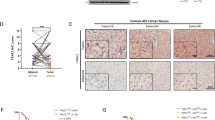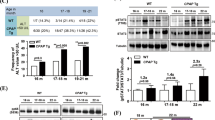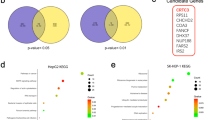Abstract
The mRNA of the ubiquitin-like modifier FAT10 has been reported to be overexpressed in 90% of hepatocellular carcinoma (HCC) and in over 80% of colon, ovary and uterus carcinomas. Elevated FAT10 expression in malignancies was attributed to transcriptional upregulation upon the loss of p53. Moreover, FAT10 induced chromosome instability in long-term in vitro culture, which led to the hypothesis that FAT10 might be involved in carcinogenesis. In this study we show that interferon (IFN)-γ and tumor necrosis factor (TNF)-α synergistically upregulated FAT10 expression in liver and colon cancer cells 10- to 100-fold. Real-time RT-PCR revealed that FAT10 mRNA was significantly overexpressed in 37 of 51 (72%) of human HCC samples and in 8 of 15 (53%) of human colon carcinomas. The FAT10 cDNA sequences in HCC samples were not mutated and intact FAT10 protein was detectable. FAT10 expression in both cancer tissues correlated with expression of the IFN-γ- and TNF-α-dependent proteasome subunit LMP2 strongly suggesting that proinflammatory cytokines caused the joint overexpression of FAT10 and LMP2. NIH3T3 transformation assays revealed that FAT10 had no transforming capability. Taken together, FAT10 qualifies as a marker for an interferon response in HCC and colon carcinoma but is not significantly overexpressed in cancers lacking a proinflammatory environment.
This is a preview of subscription content, access via your institution
Access options
Subscribe to this journal
Receive 50 print issues and online access
$259.00 per year
only $5.18 per issue
Buy this article
- Purchase on Springer Link
- Instant access to full article PDF
Prices may be subject to local taxes which are calculated during checkout




Similar content being viewed by others
Accession codes
References
Bates EFM, Ravel O, Dieu MC, Ho S, Guret C, Bridon JM et al. (1997). Identification and analysis of a novel member of the ubiquitin family expressed in dendritic cells and mature B cells. Eur J Immunol 27: 2471–2477.
Breuhahn K, Vreden S, Haddad R, Beckebaum S, Stippel D, Flemming P et al. (2004). Molecular profiling of human hepatocellular carcinoma defines mutually exclusive interferon regulation and insulin-like growth factor II overexpression. Cancer Res 64: 6058–6064.
Canaan A, Yu XF, Booth CJ, Lian J, Lazar I, Gamfi SL et al. (2006). FAT10/diubiquitin-like protein-deficient mice exhibit minimal phenotypic differences. Mol Cell Biol 26: 5180–5189.
Chiu YH, Sun Q, Chen ZJ . (2007). E1-L2 activates both ubiquitin and FAT10. Mol Cell 27: 1014–1023.
Fan W, Cai W, Parimoo S, Lennon GG, Weissman SM . (1996). Identification of seven new human MHC class I region genes around the HLA-F locus. Immunogenetics 44: 97–103.
Hipp MS, Raasi S, Groettrup M, Schmidtke G . (2004). FAT10, a ubiquitin-independent signal for proteasomal degradation. J Biol Chem 279: 16503–16510.
Hipp MS, Kalveram B, Raasi S, Groettrup M, Schmidtke G . (2005). NEDD8 ultimate buster-1L interacts with the ubiquitin-like protein FAT10 and accelerates its degradation. Mol Cell Biol 25: 3483–3491.
Kern MA, Breuhahn K, Schirmacher P . (2002). Molecular pathogenesis of human hepatocellular carcinoma. Adv Cancer Res 86: 67–112.
Khan S, van den Broek M, Schwarz K, de Giuli R, Diener PA, Groettrup M . (2001). Immunoproteasomes largely replace constitutive proteasomes during an antiviral and antibacterial immune response in the liver. J Immunol 167: 6859–6868.
Lee CG, Ren J, Cheong IS, Ban KH, Ooi LL, Yong Tan S et al. (2003). Expression of the FAT10 gene is highly upregulated in hepatocellular carcinoma and other gastrointestinal and gynecological cancers. Oncogene 22: 2592–2603.
Legler DF, Krause P, Scandella E, Singer E, Groettrup M . (2006). Prostaglandin E2 is generally required for human dendritic cell migration and exerts its effect via EP2 and EP4 receptors. J Immunol 176: 966–973.
Liu Y, Pan J, Zhang C, Fan W, Collinge M, Bender JR et al. (1999). A MHC-encoded ubiquitin-like protein (FAT10) binds noncovalently to the spindle assembly checkpoint protein MAD2. Proc Natl Acad Sci USA 96: 4313–4318.
Oliva J, Bardag-Gorce F, French BA, Li J, McPhaul L, Amidi F et al. (2008). FAT10 is an epigenetic marker for liver preneoplasia in a drug-primed mouse model of tumorigenesis. Exp Mol Pathol 84: 102–112.
Pfaffl MW, Horgan GW, Dempfle L . (2002). Relative expression software tool (REST) for group-wise comparison and statistical analysis of relative expression results in real-time PCR. Nucleic Acids Res 30: e36.
Raasi S, Schmidtke G, de Giuli R, Groettrup M . (1999). A ubiquitin-like protein which is synergistically inducible by interferon-γ and tumor necrosis factor-α. Eur J Immunol 29: 4030–4036.
Raasi S, Schmidtke G, Groettrup M . (2001). The ubiquitin-like protein FAT10 forms covalent conjugates and induces apoptosis. J Biol Chem 276: 35334–35343.
Ren JW, Kan A, Leong SH, Ooi LLPJ, Jeang KT, Chong SS et al. (2006). FAT10 plays a role in the regulation of chromosomal stability. J Biol Chem 281: 11413–11421.
Ross MJ, Wosnitzer MS, Ross MD, Granelli B, Gusella GL, Husain M et al. (2006). Role of ubiquitin-like protein FAT10 in epithelial apoptosis in renal disease. J Am Soc Nephrol 17: 996–1004.
Stohwasser R, Standera S, Peters I, Kloetzel P-M, Groettrup M . (1997). Molecular cloning of the mouse proteasome subunits MC14 and MECL-1: reciprocally regulated tissue expression of interferon-γ-modulated proteasome subunits. Eur J Immunol 27: 1182–1187.
Zhang DW, Jeang KT, Lee CGL . (2006). p53 negatively regulates the expression of FAT10, a gene upregulated in various cancers. Oncogene 25: 2318–2327.
Zhu LJ, Altmann SW . (2005). mRNA and 18S-RNA coapplication-reverse transcription for quantitative gene expression analysis. Anal Biochem 345: 102–109.
Acknowledgements
We thank Klaus Scherrer for the contribution of the iota antibody and Gerardo Alvarez for excellent technical assistance. Darius Moradpour is acknowledged for the contribution of HCC cell lines. This work was supported from the grants Az 10.05.1.145 and Az 10.06.2.183 of the Fritz Thyssen Foundation.
Author information
Authors and Affiliations
Corresponding author
Additional information
Supplementary Information accompanies the paper on the Oncogene website (http://www.nature.com/onc)
Supplementary information
Rights and permissions
About this article
Cite this article
Lukasiak, S., Schiller, C., Oehlschlaeger, P. et al. Proinflammatory cytokines cause FAT10 upregulation in cancers of liver and colon. Oncogene 27, 6068–6074 (2008). https://doi.org/10.1038/onc.2008.201
Received:
Revised:
Accepted:
Published:
Issue Date:
DOI: https://doi.org/10.1038/onc.2008.201
Keywords
This article is cited by
-
FAT10 promotes chemotherapeutic resistance in pancreatic cancer by inducing epithelial-mesenchymal transition via stabilization of FOXM1 expression
Cell Death & Disease (2022)
-
Valosin-containing protein (VCP/p97) inhibition reduces viral clearance and induces toxicity associated with muscular damage
Cell Death & Disease (2022)
-
Structures of UBA6 explain its dual specificity for ubiquitin and FAT10
Nature Communications (2022)
-
The ubiquitin-like modifier FAT10 interferes with SUMO activation
Nature Communications (2019)
-
The structure of the ubiquitin-like modifier FAT10 reveals an alternative targeting mechanism for proteasomal degradation
Nature Communications (2018)



